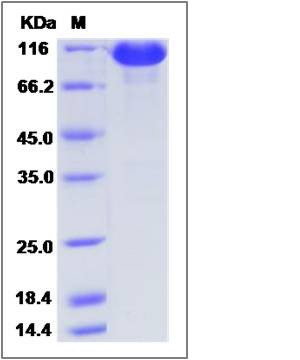Rat EphA3 Protein (Fc Tag)
EPHA3
- 100ug (NPP2847) Please inquiry
| Catalog Number | P80465-R02H |
|---|---|
| Organism Species | Rat |
| Host | Human Cells |
| Synonyms | EPHA3 |
| Molecular Weight | The recombinant rat EPHA3/Fc is a disulfide-linked homodimer. The reduced monomer comprises 762 amino acids and has a predicted molecular mass of 85.8 kDa. The apparent molecular mass of the protein is approximately 103 kDa in SDS-PAGE under reducing conditions. |
| predicted N | Glu 21 |
| SDS-PAGE |  |
| Purity | > 95 % as determined by SDS-PAGE |
| Protein Construction | A DNA sequence encoding the rat EPHA3 (EDL75897.1) (Met1-His541) was expressed with the Fc region of human IgG1 at the C-terminus. |
| Bio-activity | Measured by its binding ability in a functional ELISA. Immobilized ratEFNA5-His (P80105-R08H) at 10 μg/ml (100 μl/well) can bind rat EPHA3-Fc, The EC50 of rat EPHA3-Fc is 12.1-28.4 ng/ml. |
| Research Area | Cancer |Invasion microenvironment |Angiogenesis |Eph Receptors |
| Formulation | Lyophilized from sterile PBS, pH 7.4. 1. Normally 5 % - 8 % trehalose and mannitol are added as protectants before lyophilization. Specific concentrations are included in the hardcopy of COA. |
| Background | EPHA3 gene belongs to the ephrin receptor subfamily of the protein-tyrosine kinase family. EPH and EPH-related receptors have been implicated in mediating developmental events, particularly in the nervous system. The ephrin receptors are divided into 2 groups based on the similarity of their extracellular domain sequences and their affinities for binding ephrin-A and ephrin-B ligands. EPHA3 gene encodes a protein that binds ephrin-A ligands. EPHA3 is involved in the retinotectal mapping of neurons. It may also control the segregation but not the guidance of motor and sensory axons during neuromuscular circuit development. |
| Reference |
